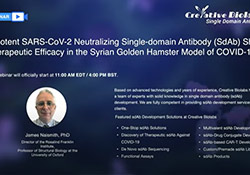Best-Fit Host Species Selection Service for Single Domain Antibody (SdAb) Discovery
Llama Alpaca Camel Shark Case Study Published Data FAQ Resources
Equipped with a world-leading VHH development platform and professional scientific staff, Creative Biolabs is proud to support high-efficiency VHH development projects for our customers all over the world. Compared with conventional
IgG, single domain antibodies present better properties, such as smaller size and higher penetrability, making them one of the most promising candidates for drug discovery and other applications. Currently, our scientists can generate novel VHHs from
different species, including llamas, alpacas, camels, and even sharks.
Llama
Like all members of the camelid family, llama antibodies have three IgG subclasses: the conventional IgG1, and the non-conventional IgG2 and IgG3. Compared with IgG1, there is a splicing defect in the CH1
exon which results in the absence of the CH1 domain in both IgG2 and IgG3. Additionally, many camel VHH sequences contain an extra pair of Cys residues in the H1 and H3 loops, forming an interloop disulfide bond. However, the
frequency of this additional disulfide bond is relatively low in llamas, and their H3 loop is significantly shorter than that of camel VHHs.
Alpaca
The alpaca is a species of South American camelid often confused with the llama. Depending on its fiber, the alpaca can be divided into two major breeds: the Huacaya alpaca and the Suri alpaca. Compared with camels and llamas, alpacas are smaller, more
tractable and widely available. Alpaca sera IgG consists of almost 50% heavy chain-only antibodies (HCAbs), most of which are of the short-hinge variety. In addition, there is only one IGHM gene with a functional CH1 splicing site in
the alpaca genome.
Camel
The camel is an even-toed ungulate in the genus Camelus. In general, camels can be divided into two breeds: the one-humped Arabian camel which makes up 94% of the world's camel population, and the two-humped Bactrian camel, which makes up
the remainder. Compared with South American camelid species, the percentage of HCAbs in the blood of camels is significantly higher, ranging from 50% to 80%.

Shark
As a typical species of cartilaginous fish, sharks have been around for over 500 million years. Compared with the various immunoglobulin isotypes in other species, sharks mainly produce IgM, IgW, and IgNAR (immunoglobulin new antigen receptor). IgNAR
is a heavy chain homodimer consisting of five constant domains and one variable region (VNAR). VNAR has proven to be a valuable source for the development of VHHs. Relative to the HCAbs in camelids, shark IgNARs are slightly less abundant, making
up about 5% of the total immunoglobulins in the blood.

With extensive rich experience in VHH development, Creative Biolabs now offers a variety of species to meet the special needs of our clients. If you are interested in our service, please do not hesitate to contact us for more details.
Published Data
-
Various Structures and Applications of sdAbs Derived from Different Species
 Fig. 1 Comparisons of structures among conventional antibody IgG and natural VHH derived from camelids
and sharks.1
Fig. 1 Comparisons of structures among conventional antibody IgG and natural VHH derived from camelids
and sharks.1
This article provides an overview regarding the applications of sdAbs from different sources as new biomarker detectors. Single-domain antibodies derived from camelids (VHH) and those derived from sharks (VNAR) exhibit numerous similarities. Both are
composed of a single variable domain, resulting in the formation of small antibody fragments with relatively low molecular weights. Besides, they demonstrate high thermal stability under extreme temperatures and conditions and exhibit high affinity
binding to their target antigens. VHH and VNAR have the potential to be utilized in various of biomedical research applications, the development of diagnostic assays, and as a basis for potential therapeutic uses. However, there are also notable differences.
VHH is derived from camelids, whereas VNAR originates from sharks, resulting in structural variations, including the absence of the CH1 domain observed in conventional antibodies in VNAR. Another discrepancy is their capacity to identify specific
types of antigens, with VNAR demonstrating enhanced abilities to recognize epitopes that are inaccessible to conventional antibodies. Currently, VHH may have reached a more advanced stage in certain fields due to its longer development history. Conversely,
recently discovered VNARs might demonstrate distinctive advantages in novel applications. Furthermore, the production methods for VHH and VNAR may diverge, potentially influencing their cost-effectiveness and scalability.
Reference
-
Leow, Chiuan Herng, et al. "Single domain antibodies as new biomarker detectors." Diagnostics 7.4 (2017): 52. Distributed under Open Access license CC BY 4.0, without modification.
FAQ
1. What impact does the host species have on the quality and affinity of the resulting VHH antibodies?
Genetic diversity and changes in immune system dynamics between host species influence the production of VHH antibodies with varying affinities and specificities. Generally, all camelid species have the ability to produce strong antibodies. However, antigen
presentation and overall health can impact the quality of VHH antibodies.
2. What is the impact of the selected host species on the potential applications of the VHH antibodies?
The determination of the host species may impact the stability and affinity of the discovered VHH antibodies, which could have a mixed influence on their efficacy in downstream applications such as diagnostics, therapeutics, and research tools.
Resources
We are offering highly customized CRO services to assist your Single Domain Antibody (sdAb) related projects. Please Contact Us for more details.



 Fig. 1 Comparisons of structures among conventional antibody IgG and natural VHH derived from camelids
and sharks.1
Fig. 1 Comparisons of structures among conventional antibody IgG and natural VHH derived from camelids
and sharks.1

















